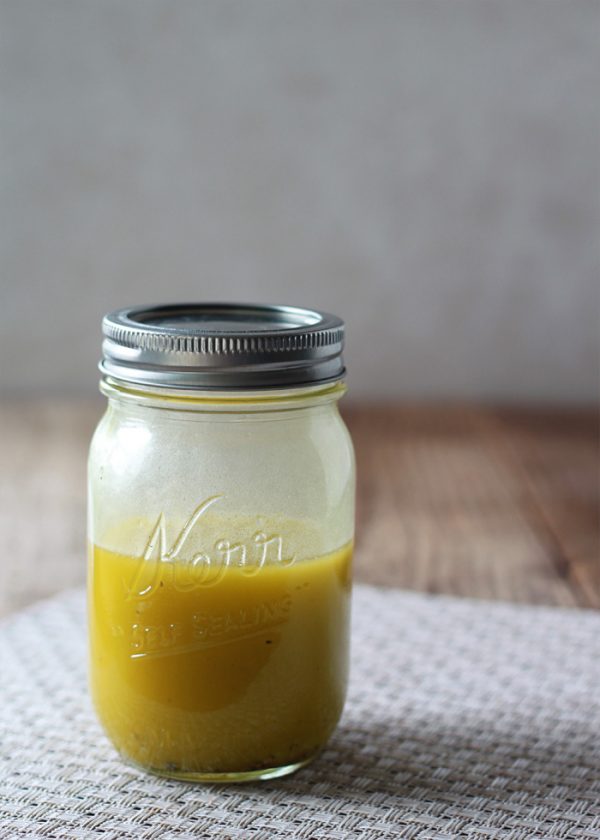
I have to admit that I was dubious about making salads in a jar. How do you keep ingredients fresh and prevent soggy, limp salad greens? With some trial and error, I discovered the key to success is in the order of the ingredients you layer in the jar! Salads in a jar are great – saving money, time, and ensuring you have something healthy available when you don’t feel like cooking! With these simple how to’s, you can easily have salads in a jar on hand to enjoy.
What you need:
- 1 to 4 tablespoons salad dressing (see recipe below)
- Mix of raw & cooked vegetables, fresh and dried fruit, nuts, cheese, etc
- Salad greens
- Wide-mouth canning jars with tight-fitting lids: pint jars for side salads, quart jars for individual meal-sized salads, 2-quart jars (or larger) for multiple servings
Layer the ingredients in the jar, in this order (from bottom of the jar to top_)
Salad dressing: Pour 1 to 4 tablespoons of your favorite salad dressing in the bottom of the jar. Adjust the amount of dressing depending on the size of the salad you are making and your personal preference.
Hard vegetables: Next, add any hard-chopped vegetables you’re including in your salad, like carrots, cucumbers, red and green peppers, cooked beets, and fennel.
Beans, grains, and pasta: Next, add any beans, grains, and/or pasta, like chickpeas, black beans, cooked barley, cooked rice, and pasta corkscrews.
Cheese and proteins (optional): If you’ll be eating the salad within the day, add a layer of diced or crumbled cheese and proteins like tuna fish, diced (cooked) chicken, hard-boiled eggs, or cubed tofu. If you’re making salads ahead to eat throughout the week, wait to add these ingredients until the day you’re planning to eat the salad and add them on top of the jar. You may pre-cut cheese and most proteins ahead of time, storing them separately and adding to the jar on the day you’re planning on eating the salad.
Softer vegetables and fruits (optional): Next, add any soft vegetables or fruits, like avocados, tomatoes, diced strawberries, or dried apricots. If you’re making salads ahead to eat throughout the week, wait to add these ingredients until the day you’re planning to eat the salad and add them to the top of the jar.
Nuts, seeds, and lighter grains: Next, add any nuts or seeds, like almonds, walnuts, and sunflower seeds. If you’re making a salad with lighter, more absorbent grains like quinoa or millet, add them in this layer instead of with the beans.
Salad greens: Last but not least, fill the rest of the jar with salad greens. Use your hands to tear them into bite-sized pieces. It’s fine to pack them into the jar compactly.
Storing the salad: Screw the lid on the jar and refrigerate for up to 5 days. If you’re including any cheese, proteins, or soft fruits and vegetables, add these to the top of the jar the morning you plan to eat your salad.
Tossing and eating the salad: When ready to eat, unscrew the lid and shake the salad into the bowl. The action of shaking the salad into the bowl is usually enough to mix the salad with the dressing. If not, toss gently with a fork until coated.

| Prep Time | 5-10 minutes |
| Servings |
|
- 3 tbsp extra virgin olive oil (or a more neutral-flavored oil like grapeseed, canola, or vegetable)
- 1 tbsp white wine vinegar (or balsamic, apple cider, rice, sherry, or other wine vinegar)
- pinch kosher salt
- freshly ground pepper
- 1-2 tbsp fresh chopped basil, parsley, cilantro, or mint (dried herbs work, too, just use 1-2 teaspoons instead)
- 1 clove garlic - freshly minced
- 2 tsp ginger - grated or minced
- 2 tbsp Parmesan cheese - freshly grated or crumbled (or Pecorino Romano, Gorgonzola, or feta)
- pinch red pepper flakes
- 1 tsp dijon mustard
- 1/2-1 tsp honey
Ingredients
Optional add ins
|

|
- Add all the ingredients to a small mason jar, screw on the lid, and shake until blended. You can also whisk the ingredients together in a bowl or whirr them together in a blender. Taste and adjust seasonings if desired. Add to salad, toss, and serve. Keep leftover dressing in a sealed jar in the refrigerator for 2 – 3 days.
